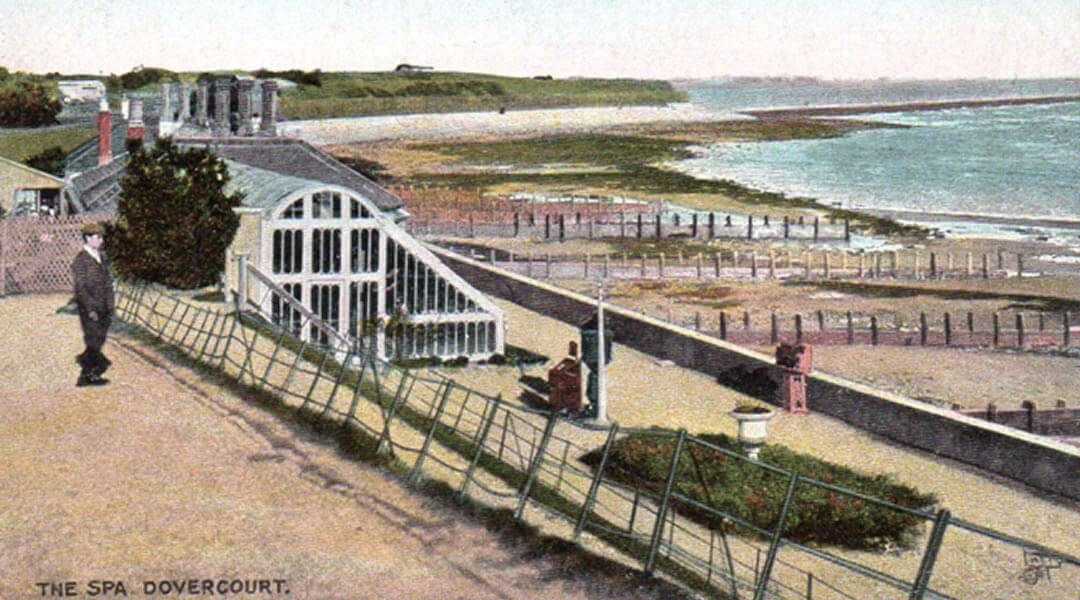John Bagshaw, Member of Parliament for Harwich from 1847 initially living at his shipyard residence. In the late 1840s he acquired the lease of 21 acres of land from Her Majesty’s Commissioners of Woods & Forrests land and built an impressive Italian style building with ten bedrooms it was brick built and stuccoed. Accommodation included a library, drawing room, boudoir and dining room opening out into a conservatory and servants quarters. The property known as Cliffe House was situated in 21 acres of land now the site of Cliff Park. The house is thought to have been completed in 1848 where he moved to following the sale of the shipyard. John discovered a chalybeate spring and saw the potential of making Dovercourt a spa town equivalent to that of Tunbridge Wells. He owned the Royal Naval Shipyard lease, now the site of Navyard Wharf which he sold on 15th December 1848 to George Bayley. John Bagshaw leased further land from Her Majesty’s Commissioners of Woods & Forrests and built spa facilities including a pump house, library, reading room, an assembly room measuring 25 feet by 23 feet six inches with large bay windows, the ceilings formed a canopy, the walls panelled with enriched cornices the building also had a museum. Four bath rooms with hot and cold water with reclining shower baths were the central feature. The tudor style Spa in marine blue lais cement was officially opened on 28th August 1854. Nearby the Royal Harwich Yacht Club (founded in September 1844) had their headquarters but in 1865 moved to the Great Eastern Hotel. Health problems with the spring 1892 led that part of the facility being closed, the remaining part of the business being closed at the declaration of war and not re-opening again.
The Royal Harwich Yacht Club was given its Royal status when in 1845 Queen Adelaide became a patron of the club later followed by Queen Victoria and Prince Albert. The Prince of Wales (later Edward VII) attended the regatta in 1897.
To enhance the seafront facilities the cliff slopes were landscaped and a promenade built constructed from the spa to Mill Lane. This connected to the promenade from the Esplanade that work had commenced on its construction in August 1849. In 1900 the council acquired further land extending the promenade to Beach Road.
Many of the buildings built by John Bagshaw remain to this day the most impressive being Orwell Terrace, but there are still many more residential properties around the town. The coming of the railways in August 1854 saw a significant increase in day trippers visiting Dovercourt as a seaside resort town. He saw the potential of longer stay visitors and built Queen’s Head Hotel and Victoria Hotel. Many of these properties incorporated recycled timber from the shipyard. Under construction in 1859 was a pair of semi detached houses on Marine Parade. Sadly John Bagshaw’s dreams were not a financial success and was declared bankrupt on 9th March 1859 with debts of £45,000 (£50M in todays money).
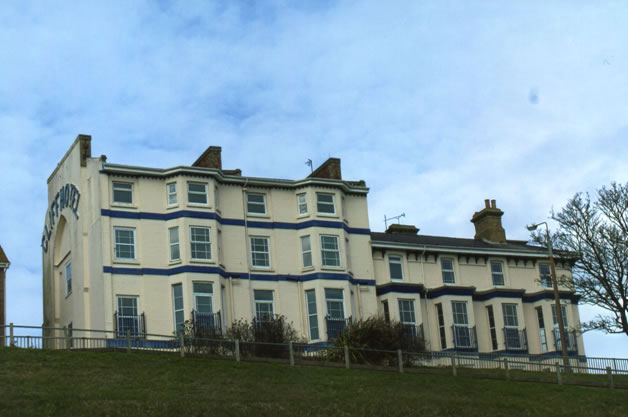
Over the coming months a series of auctions took place selling of John Bagshaw’s property portfolio. His son Robert John Bagshaw purchased some including Victoria Hotel and Queen’s Head Hotel. The two residences in Marine Parade over looking the German Ocean (North Sea) were sold to Henry Tyler a builder (today he would be referred as a property developer) who completed the property and opened in 1860 as Cliff Hotel. This sandy yellow brick building (the brickwork painted white by local builder Edward Saunders during the spring of 1910) had been designed by Mr H. Darken. Sadly two years later Mr Tyler was declared bankrupt resulting in the hotel being auctioned on the 3rd October 1862 at the Three Cups Hotel raising £2,420, the purchaser being Mr T. Daniel. The land originally extended to Lee Road with tennis courts at the junction and gardens on the south of the building. Some of this was sold for two houses to raise funds to extend the hotel northwards re-opening in June 1866 adding 12 suites all facing the sea along with a coffee room. An alcohol licence was granted in September 1867. A further land sale of the tennis court land raised funds for a function room on the east side of the hotel opening in July 1882 it was originally known as the Cliff Pavilion and in 1897 the pavilion was enlarged and renamed Victoria Hall being used for dancing, shows boxing and a gymnasium. Between 1925 and 1927 it was known as Palais de Danse holding weekly dances on a Saturday night with a 2/6p admission fee in late 1927 when Trust Houses took over it reverted to Victoria Hall.
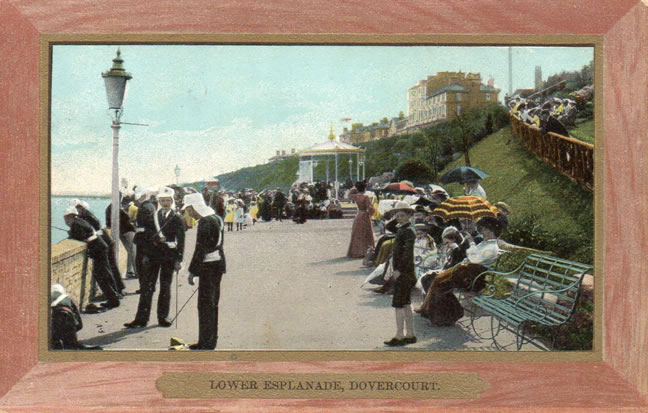
About 1860 the Baths and Bathing Refreshment Rooms was set up and managed by Mr Raymond Howard on what was the foreshore slightly to the south of the Dovercourt lighthouses. The site sold refreshments and managed the bathing machines for swimmers on the beach. At this time there was strict clothing rules requiring swimmers to change in private hence changing hut on wheels. On 27th March 1866 the timber building was destroyed by fire. The facility was rebuilt at a cost of £460 and re-opened in August that same year now holding a beer licence.
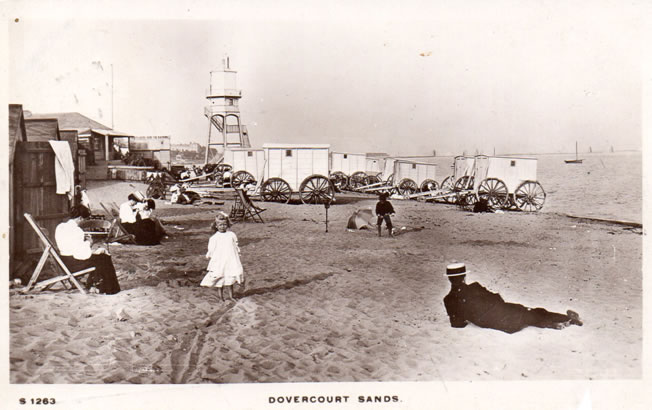
About 1888 the site became known as the Phoenix Hotel and managed by Mr Warren Ellis for Bullard and Sons. History repeated itself as on 28th May 1914 when the new Phoenix caught fire around midnight. A passing policeman raised the alarm awakening the managers Mr & Mrs Everatt and their two daughters, the fire brigade were quickly on the scene but the timber building could not be saved. The nearby bazaar selling souvenirs was also destroyed along with an overhead railway and helter skelter at the Retreat.
The Retreat probably built in 1889 on what is now an open space opposite the lighthouses on the south side of the Beach Road junction. It consisted of a large three storey building with a corrugated roof with dormitories to accommodate some 250 children deprived children usually but not always from London on a seaside holiday. The site also included a helter-skelter, roller skating rink, and refreshment rooms and was open for general public use. An advertisement of 1923 give the cost of one weeks visit at 2.5 guineas per person. The site was requisitioned for military use in 1940 then with the war over purchased by Harwich Borough Council for £3,190 and demolished in 1947.
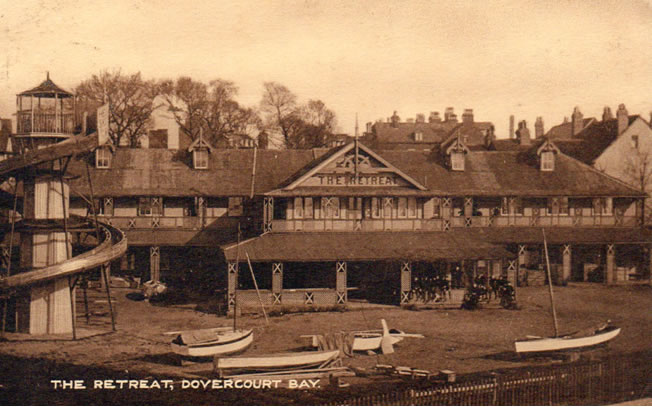
With the holiday makers demand for drinks Mr Fred Kettle opened a mineral water business in 1891 working in the cellars of the British Flag public house. In October 1904 the business having outgrown those premises moved to Stour Road opposite the Anchor Hotel and behind Cann’s Shipyard. In 1920 the company won a bronze medal for the quality of their products. In July 1923 Fred Kettle died resulting in son A. B. Kettle taking over, the business from then on known as F. Kettle and Sons Ltd. On 23rd October 1923 fire destroyed the buildings and their new motor van. With the help of local mineral water competitor Mr Charles Vail, Kettle’s continued in business moving to a new site at the corner of Gwynne Road opposite Cliff Park. In October 1960 the business was taken over by Mr Harry Smith retaining it name, all ten employees retained their jobs. The business closed in December 1986.
Chas Vail also ran a mineral water production business from a site where the current pumping station in Fernlea Road now stands. The business appears to have only run between the two world wars.
In January 1901 Harwich Borough Council purchased from the Robert Bagshaw estate the land from Banksea House to Beach Road and had constructed a promenade and landscaped the cliffs, at this time the Mill Lane tunnel was widened. At mid way along the promenade a shelter was constructed with changing rooms and toilets on the lower level and refreshment rooms on the upper level, these were run my Mr W. F. Gray. In 1934 some rebuilding of this property took place at a cost of £144, by then Mr Hockley was the proprietor. The Harwich Co-operative Society donated a band stand which they officially handed over in January 1902. Concerts were a regular summer feature here usually by the H.M.S. Ganges band of that from Brantham Xylonite.
After taking only twelve months to build the Alexandra Hotel on Marine Parade at the corner of Kingsway was officially opened on 25th May 1903. Guests were accommodated in 39 bedrooms on the first and second floors, ground floor facilities including a drawing room, dining room and at the south end a theatre and cinema with seating for 500 patrons. Further south were gardens, tennis courts and a bowling green. At the end of the 1920s these facilities were replaced by a 9 hole putting green.
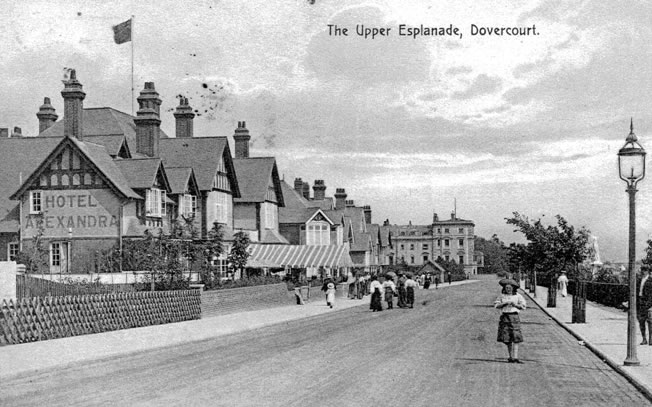
The first British monarch to visit the town in the 20th century was King Edward VII on 19th May 1905. He arrived by train at Dovercourt station and after inspecting the town’s military installations was given dinner at Alexandra Hotel before returning to London by train.
Between 1st May 1913 and 14th December 1972 Dovercourt railway station was named Dovercourt Bay. W. H. Smith opened a kiosk on platform 1 on 18th June 1874 remaining in use until about 1970.
To commemorate the coronation of George V and Queen Mary Harwich Borough Council leased from Her Majesty’s Commissioners of Woods & Forest the 25 acres of land of the former Cliffe House, its land and the spa buildings in February 1910. The house had already been demolished with the spa building following. The land was landscaped with gardens, a band stand and shelters, the original summer house being retained. On 22nd June 1911 the mayor S. R. Groom officially opened the towns new park, Cliff Park. 25 years later an enclosed 150 square yard children’s play facility was opened to commemorate the King’s silver jubilee by Mayor Charlie Hills, swings, a round-about and a slide were included.
The town’s first cinema, the Electric Palace had opened on 29th November 1911 in Harwich quickly being followed by the Empire in Kingsway opening on 24th March 1913 showing three films, “My Baby”, Jim’s Vindication” and “Good for Nothing”. The Regent (now Dolphin Sails), close to the B.P. garage) followed opening on 18th January 1927.
Messrs Bullard & Sons were quick to replace their Phoenix Hotel with work commencing in 1915 but due to war pressures builders were required on war duties hence work was not completed until 1919.
The First World War had closed Dovercourt as a seaside resort but with the war over Harwich Borough Council were keen to provide fresh momentum to the town and by now the bathing machines were obsolete. They purchased land, mudflats and salting from Mr P. J. Graves for £1,000 to extend the promenade southward to the length that it is today with work commencing. Work commenced in 1922 and cost £18,925. Three new hard court tennis courts were officially opened on 25th June 1925 by Mayor T. J. Denny, two weeks later two similar courts were opened on St Helen’s Green.In preparation for the 1924 Whitsun Bank Holiday a clockwork golf course, putting green, boating lake, yachting pond and paddling pool were also constructed.
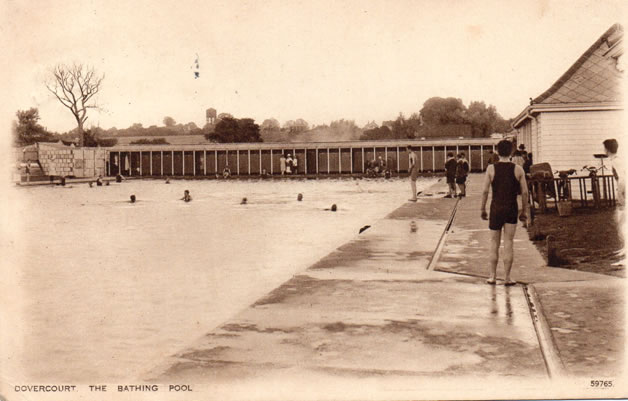
To provide safe bathing irrespective of the tides it was decided to build a bathing pool on the site of today’s swimming pool. Local builders Fisher & Woods were awarded the £6,500 contract for the 210 feet long 75 feet wide with depths from 2 feet six inches to 6 feet, changing rooms were provided at each end of the pool for men and ladies. The new facility was opened on 5th July 1924 by mayor Mrs Lucy Hill.
The bazaar at the corner of Beach Road and Lower Marine Parade was replaced by an amusement hall opening for the start of the 1925 summer season.
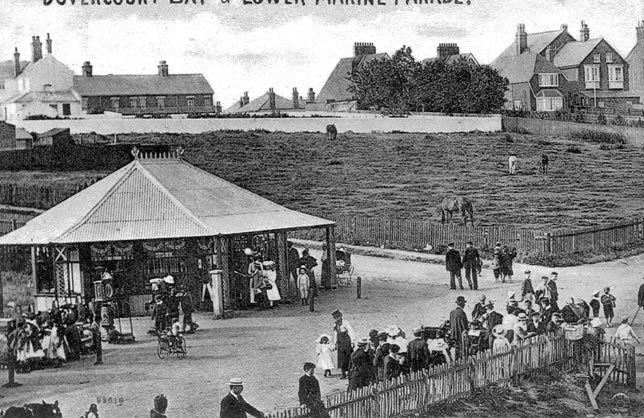
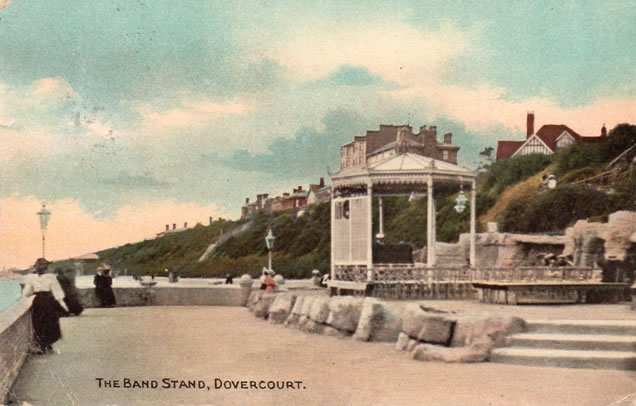
The 1901 built and opened in January 1902 bandstand had proved to be very popular but cold winds blowing in from the sea left the audience cold. It was decided to construct a glass clad enclosure along the sea wall to shelter them being officially opened by High Steward Richard Abdy on 14th July 1929 having cost £1,500. Although the public liked the newly protected bandstand it was felt a new purpose built pavilion should be build. The new Cliff Pavilion was officially opened by Mayor Rose Hill on 16th July 1932. It was constructed of steel frames and glass clad making it light and airy. Notcutts of Woodbridge provided help with the design of the interior and provided the floral displays. Seating for provided for 750 patrons though the Council received complaints as the grand piano had not been purchased though a local business. Over the next forty years the Cliff Pavilion hosted countless dances, exhibitions, concerts and shows with famous names making appearances including Isabel Bailey, Bamber Gascoine, David Nixon, Bob Monkhouse and Ronnie Scott with his orchestra. On 22nd March 1955 the “Have a Go” radio programme was broadcast from the pavilion with Wilfred Pickles with his wife Mabel and Harry Hudson the pianist.
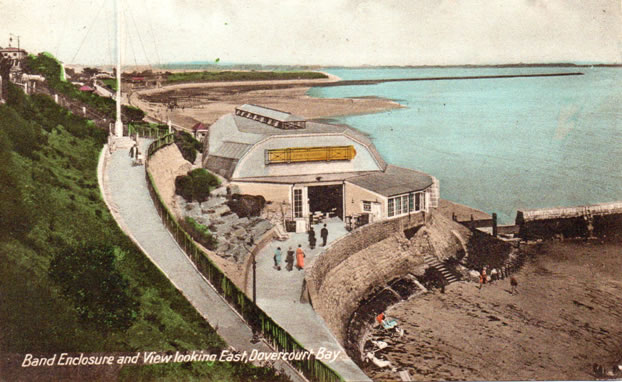
Dovercourt Bowls Club had been formed in June 1922 using the greens at Alexandra Hotel. They acquired a site close to the tennis courts where cumberland turf was laid at a cost of £1,500 being officially opened on 4th June 1932.
Dovercourt held its first summer carnival in July 1933 with a week of festivities including dances, competitions and ending with a grand processions being led by Robert Starling on horseback followed by the Marine Workshops Carnival Band and their “big heads”.
In January 1937 the Harwich Borough Council purchased some 76 acres of land from the lighthouses southward for £75,000 40 of these together with a further 18 acres were leased to the Dovercourt Bay Holiday Camp & Lido Company for the purpose of building a holiday camp. With 100 workers the camp was completed in sixteen weeks at a cost of £50,000. Accommodation was provided for 1,500 guests facilities included dining room, bars, ballroom, swimming pool, nine hole putting green tennis courts, boating lake and sports facilities. The whole site was landscaped with 4,000 rose bushes and 2,000 poplar trees. In the first season 6,000 people holidayed at the camp. In preparation for the 1939 season a billiard room was built and the ballroom enlarged and a new satin smooth oak floor laid.
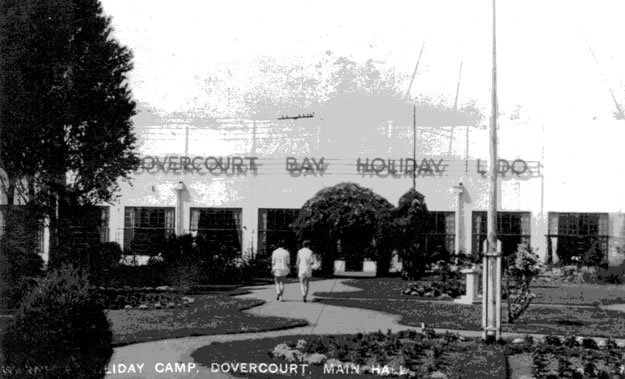
By the 1930s the Empire cinema was proving to be too small, in 1936 work commenced 1,450 seat cinema to replace it. On 1st June 1938 the Regal cinema opened with the showing of “100 Men and a Girl” followed by “Two’s Company”.
During World War 2 the seaside resort closed down with its facilities making way for military personnel.With the war now over the Cliff Pavillion re-opened 20th May 1945 with the “Peter Stuart Show”. On 1st June 1946 Warner’s holiday camp having been repaired and re-decorated opening for the summer season. Messrs Downs & Gage landscaped the the golf club re-opening in September 1946. £1,800 was allocated to construct a roller skating rink for the 1946 season though not officially opened until 27th September by professional skaters Harry Taylor and Barbara Hanson displaying their skills. The old “Tom Thumb” golf course next to the tennis courts and now a cafe became a children’s play area with regular performances from Punch and Judy. Dovercourt swimming pool closed in 1940 for military training use re-opened on 5th June 1948.
In 1948 “The Gables” at the corner of Marine Parade and Cliff Road was converted into a hotel. This property had been built in 1892 as a private house and used as a nursing home during the war.
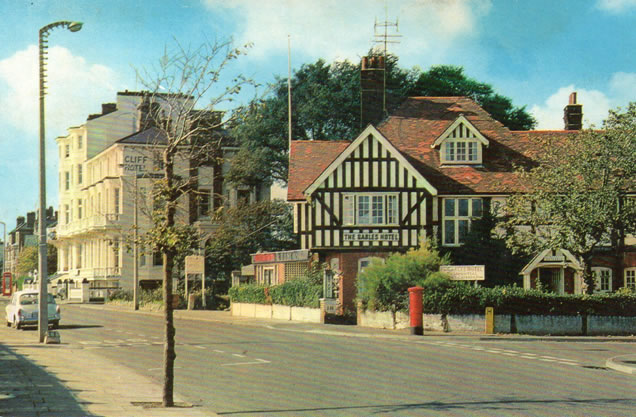
In 1950 Mr C. J. Vidler opened the Dovercourt Caravan Site with seven caravans. By 1954 facilities had been improved considerably with the number of caravans rising to 250. Facilities continued to be improved and by the end of the century there were 550 caravans on site.
Mr P. M. Fitchew opened a cafe at 83 High Street known as Corals Cafe the business soon moved to the rear of what is today’s Baldwin’s store in Kingsway, its entrance in Milton Road. With war time shortages Mr Fitchew took over Milton Hall at the rear of the Kingsway Church in 1948 and commenced producing his own ice cream, known as Coral’s ice-cream named after his daughter and Topsy ice-lollies which was also sold a various shops around town. Mr Fitchew also took over the running of the Beach Cafe Lower Road on the site of the current slot machine arcade, an ice cream parlour at the skating rink, a cafe at the west end beach and shop along a with cafe at the caravan site. His ice-cream was not popular so at the end of 1953 gave up ice-cream manufacture and bought in from Walls. Mr Fitchew also moved his town cafe to 143 Kingsway now known as Coral’s Rendezvous Cafe. In 1957 the business was taken over by Mr F. W. Shaw.
To supply the holiday trade in June 1948 under the name Tollgate Caterers Ltd Mr V Pilbeam opened his new business in the grounds of the current funeral directors in Oakley Road. He started to produce crisps and soon outgrew his premises. In September 1949 he took over MacBrides workshops in Albemarle street opposite the Anchor hotel with the company now known as the East Anglian Crisp Company and were soon producing 1,000 bags a week employing 15 staff working two shifts. The business went into decline and was closed in 1959.
The 1950s saw television taking over the public’s evening entertainment. The Regent closed on 3rd October 1959 followed by the Regal on 10th June 1972 with “Gumshoe” supported by “Thunder at the Border” making up the last night’s show.
A ferris wheel and amusement site opened on what had been a car park at the bottom of The Drive in 1960 but due to local residents complaining about the noise it only survived for two years.
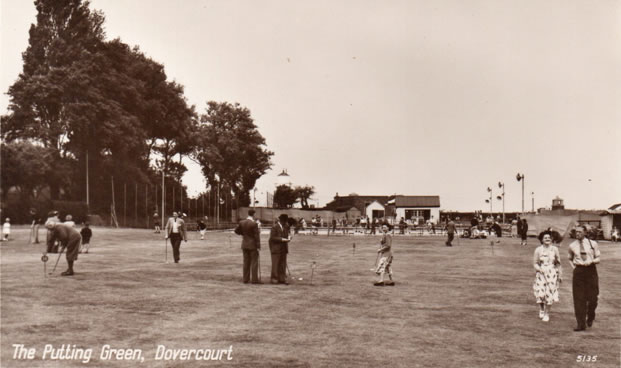
The Dovercourt swimming pool with a dividing wall built across the pool to divide youngster from the adults. In 1963 it was closed for major refurbishment but was finally closed at the end of the 1983 season being replaced on the same site by a new pool. 1953 saw the paddling pool that had for years suffered from leaks was filled in to form an open space. With the advent of package holidays and lifestyle changes Dovercourt decreased in popularity as a resort. At the end of the 1967 season the Harwich Borough Council stopped providing deckchairs. Cracks were showing i the cliffs before they finally slipped. In June 1971 the council allocated £580,00 to demolish the Cliff Pavilion and construct a new promenade further out to sea. The Gables hotel closed at the end of the 1972 season making way for new flats.
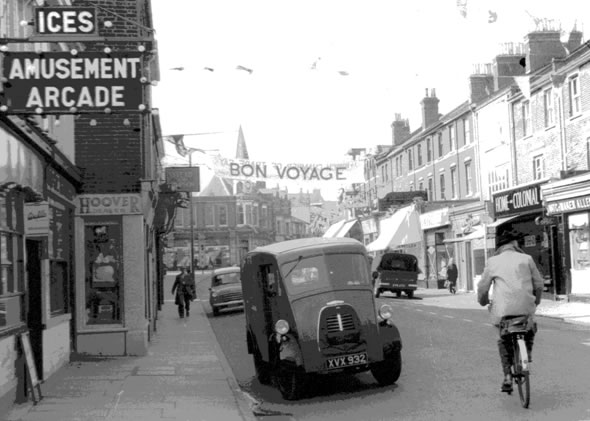
Warners Holiday Camp was used off season between October 1979 and October 1987 for the filming of the popular television series Hi De Hi but the camp closed in September 1990 not now fitting into Warners future plans.
Changes in holday patterns has led to a reduction in hotels and guest houses but the caravan sites are a popular as ever. Dovercourt remains an ideal resort for day trippers with its “blue flag” beaches and safe bathing.
